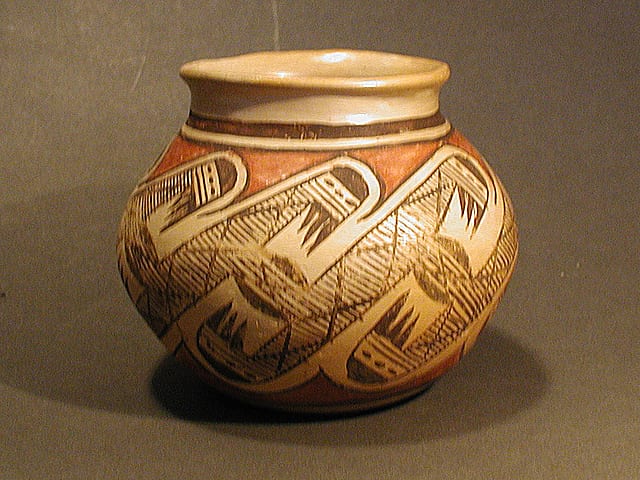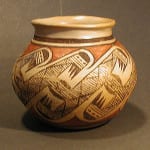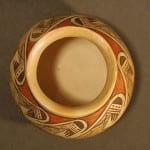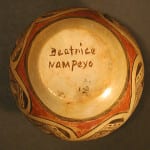This pot features the Nampeyo family “migration pattern” design. Neither the form of the pot nor the painting is proficient: the edge of the pot is uneven, the painting (particularly the three “feathers” at the ends of the wings) is imprecise. The design is somewhat worn. Nevertheless, 2005-04 is the best example of Beatrice Nampeyo’s work I know.
For a much smaller and simpler pot by Beatrice in this collection, see 2002-08.
The only other Beatrice pot I have even seen a photograph of is shown in Seven Families in Pueblo Pottery, p. 34. Of the three pots, the design on 2005-04 is by far the finest.
Born in 1912, the fourth of Annie’s six children, Beatrice was a young woman when she died in 1942. She was about 18 years old when the Great Depression began, and she was 29 when the U.S. entered World War II—a year before her untimely death. Both the Depression and the war drastically reduced the flow of tourists to the remote Hopi mesas, and thus reduced the demand for Hopi pottery. This may be why Rick Dillingham writes that Beatrice “was (only) briefly involved with pottery” and thus why there are so few known Beatrice pots (Barsook, 1974:34). Moreover, when Annie was a young woman, her mother (“Old Lady” Nampeyo) was producing a great deal of pottery and Annie joined her as a full partner. According the Blairs, when Annie was married her involvement with her mother’s work decreased as her family (and family responsibilities) grew (1999:180 and 184).
By the time Beatrice was a young woman, her mother was probably making little pottery—both because of a busy family life and because of health problems. In short, unlike her mother, Beatrice may have grown up with a mother who was a famous potter but who was not making much pottery and was not focused on developing Beatrice’s pottery skills.




